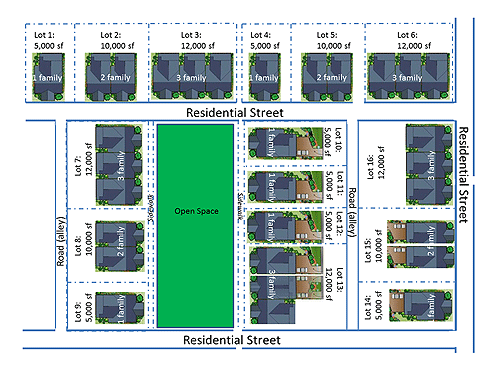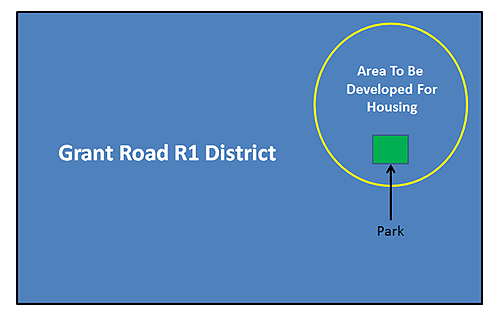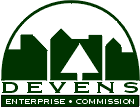(a) Goals
1. To provide a streamlined development review process that promotes residential development that meets a variety of housing needs, protects the environment, furthers energy, water and resource efficiency, and complements residential development patterns at Devens by encouraging:
a. Development on small lots;
b. A connected system of trails and open space;
c. Housing diversity;
d. A system of safe, accessible, multi-purpose streets and sidewalks;
e. Development designed primarily to accommodate people, not cars; and
f. The goals and objectives of the Reuse Plan and By-Laws
(b) Applicability: Applicants for approval of projects located in the Residential I District may develop in accordance with these IRD R1 regulations instead of 974 CMR 5.01.
(c) Review Standards
1. Applicants shall demonstrate to the satisfaction of the DEC, that an IRD R1 project:
a. Complies with the By-Laws and Regulations except as otherwise noted in the regulations set forth below; and
b. The development plan is superior to a conventional plan providing for the construction of one building on one lot, in the way it preserves open space, minimizes environmental disruption, and allows for more efficient provision of services to the residents of the development than would be available under a conventional approach; and
c. For projects with 25 acres or less, the project is designed in a manner that shows sensitivity (i.e., compatibility) with existing conditions and to the concerns of adjacent users by taking into consideration the proximity of proposed buildings to adjacent lot lines; the nature and extent of existing or proposed perimeter buffers on the lot and screening areas.
d. Compliance with the Requirements and Design Standards as set forth in this section, except as may be waived by the DEC.
(d) Process
1. At a public hearing on an application for a Unified Permit, Applicant demonstrates to the satisfaction of the DEC, that the project complies with these IRD R1 regulations, and the applicable sections of Subdivision (974 CMR 2.00) and Site Plan Approval (974 CMR 3:00).
2. For projects with Lots, Applicant demonstrates, to the satisfaction of the Land Use Administrator, that the project complies with Level One Lotting requirements.
3. Applicant applies for building permit.
(e) Neighborhood Development Design Standards
1. Applicants shall demonstrate, to the satisfaction of the DEC, that the project complies with the following:
a. Maximum Block Length: No longer than 800 feet as measured from the center line of intersecting Streets and/or Roads, sidewalks and/or trails.
b. Density: There is an average of at least 7 Dwelling Units per acre in the Area To Be Developed For Housing. As part of its Permit application, the Applicant shall provide a sketch of the Area to Be Developed for Housing, which for projects over 7 acres shall include a Park [see subsection 5.02(1) (k) below], the shape of which is subject to concurrence by the Director, for purposes of calculating Minimum Density.
c. Minimum Percent of Multi-Family Dwelling Units: At least 15% of the Dwelling Units in a project are Multi-Family.
d. Setbacks as set forth in the By-Laws, but see definition in these IRD R1 regulations.
2. Frontage on Roads: The front façade of Dwelling Units may abut Open Space so long as there is a Road at the rear of these Units that is adequate for emergency vehicle access, as shown in Figure 2. In such cases, minimum frontage requirements may be achieved by the rear lot boundary contiguous with the Road that provides adequate emergency access. Dwelling units shall be accessible from the front via a sidewalk or multi-purpose trail. The front lot line shall be the line abutting open space and sidewalk.
Figure 2: Dwelling Units Abutting Open Space

(f) Lot Development Design Standards
1. Applicants shall demonstrate, to the satisfaction of the DEC, that the project complies with Table 1: Lot Development Area, Frontage and Setback Design Standards.
Table 1: Lot Development Area, Frontage and Setback Design Standards
Residential Building Type |
Max. Lot Area
Square Feet (sf) |
Min. Lot Area
Square Feet (sf) |
Min. Lot Frontage |
Min. Front, Side + Rear Yard Setback |
Maximum Front Yard Setback |
Single/
Two-Family* |
10,000sf |
5,000sf |
50' |
5' |
25'** |
Multi-Family |
10,000sf base, plus 2,500sf per Dwelling Unit |
5,000sf base, plus 1,500sf per Dwelling Unit |
50' |
5' |
25'** |
* Maximum Lot Area for each Single-Family Dwelling Unit is 10,000sf; it is also 10,000sf for a Two-Family Building
** Maximum Front Yard Setback shall be reduced to 15' for single story buildings
2. Lots shall be configured so they are not bisected by a Street or Road.
(g) Building Design Standards
1. Prior to issuance of a Building Permit, the Applicant shall provide the DEC with:
a. A letter of commitment that it will use US Environmental Protection Agency (EPA) Water Sense plumbing fixtures only and low/no Volitile Organic Compounds (VOC) paints, coatings, sealants adhesives and finishes;
b. A written description of the building's energy features, a compliance report by a Residential Energy Services Network (RESNET) certified Home Energy Rating System (HERS) rater demonstrating a HERS index rating of 60 or less, and a statement that the rating score is "based on plans."
2. Prior to issuance of a Certificate of Occupancy, the Applicant shall:
a. Certify to the DEC that the building(s) include only EPA Water Sense plumbing fixtures and that it has used only low/no VOC paints, coatings, sealants adhesives and finishes.
b. Submit to the DEC a completed Energy Star Qualified Homes Thermal Bypass Inspection Checklist and final verification by a RESNET-certified rater of the HERS index rating of 60 or less.
(h) General Design Standards
1. Prior to the granting of a Unified Permit, the Applicant shall demonstrate, to the satisfaction of the DEC that:
a. The project complies with the Devens By-Laws and Rules and Regulations, as they may be interpreted or varied by these IRD R1 regulations.
b. The project complies with the Design Standards in 2.04(4)(b)1.c-j (Review Criteria) and 974 CMR 2.07, even if no new Street or Road is proposed, unless a Design Standard is varied by these IRD R1 regulations.
2. At least 60 days prior to issuance of a Certificate of Occupancy:
a. if the project is a condominium or involves a homeowner's association, Applicant shall provide the DEC with condominium or homeowner's association documents for review and approval as to compliance with the Open Space and Moderate-Income Dwelling Unit (MIDU) requirements of these IRD R1 regulations.
b. If required by the DEC, Applicant shall provide the DEC with a maintenance plan and/or Conservation Restriction, for review and approval if consistent with these IRD R1 Regulations.
(i) Housing Requirements
1. Prior to the granting of a Unified Permit, the Applicant shall demonstrate, to the satisfaction of the DEC that:
a. At least 15% of the Dwelling Units in the project shall include at least 3 bedrooms;
b. The project includes a mix of residential building types (Single-,Two-, and Multi-Family) and number of bedrooms per Dwelling Unit; and
c. The project includes recreational facilities, including playground(s).
(j) Moderate-Income Dwelling Unit (MIDU) Housing Requirements
1. Prior to the granting of a Unified Permit, the Applicant shall demonstrate, to the satisfaction of the DEC, that:
a. Twenty-two percent (22%) of the Dwelling Units are Affordable in perpetuity to and occupied by Moderate-Income households.
b. The sales price or rent of the MIDUs are Affordable (refer to Definition Section 5.02(1)(l) for definitions of "Moderate Income" and "Affordable").
c. MIDUs are dispersed throughout the project, have the same type, number of bedrooms, architectural styles and/or varied exterior architectural features, and interior amenities as the market-rate Dwelling Units, and the developer requests building permits and certificates of occupancy for MIDUs at the same time and in proportion to the market-rate Dwelling Units. For example, if the developer is requesting building permits for three market-rate units he shall also request at least one building permit for a MIDU.
2. At least 60 days prior to obtaining a Building Permit, Applicant shall:
a. Provide the DEC with a draft regulatory agreement and deed rider for review and approval, the forms for which are those used in the DHCD Local Initiative Program (LIP), modified to apply to MIDU.
b. Demonstrate to the satisfaction of the DEC that the MIDU meet the following LIP requirements in the DHCD Guidelines, Updated May 2013, G.L. C.40B Comprehensive Permit Projects Subsidized Housing Inventory (the 40B Guidelines):
• Articles III. C and D (Affirmative Marketing and Local Preference);
• Articles VI.B.4, 5, 6 and 7: [Design and Construction Standards, Income and Asset Limits (to be used for methodology, not pricing), Maximum Sales Prices and Rents, and Lease Provisions); and
• Article VI.E. (Initial Sales, Resales and Refinancing)
The DEC may, from time to time, promulgate a guidance document interpreting the sections of the 40B Guidelines listed above as they are to be applied to Devens.
(k) Open Space and Park Design Standards
1. Objectives: Preserve the open space buffer between the Innovation Technology Business and Residential 1 Districts, facilitate connections to Rogers Field and USFWS Oxbow Wildlife Refuge Visitor Contact Station on Hospital Road, protect Steep Slopes identified on Slope Resource Area map, and provide new Open Space and Parks.
2. Prior to the grant of a Unified Permit, the Applicant shall demonstrate, to the satisfaction of the DEC, that the project complies with the following:
a. Minimum Open Space Per Dwelling Unit: Calculated by subtracting the Lot Area per dwelling unit of the project from the Minimum Lot Area required by the By-Laws (15,000sf). For example, if the Lot Area for a Dwelling Unit is 5,000sf, the Minimum Open Space Per Dwelling Unit requirement is 10,000sf. There is no Minimum Open Space requirement for Multi-Family Dwelling Units.
b. Park Requirement for Larger Projects: Projects larger than 7 acres shall include in perpetuity a Park within the Area To Be Developed For Housing (see Figure 1 below) of at least one continuous half-acre.
Figure 1: Park Requirement for Larger Projects

c. Open Space Proximity Requirement: All Dwelling Units shall be located within 1/4 mile of Open Space that is publicly-accessible in perpetuity of at least 1/6 acre (as measured from the front door of each building to the nearest boundary of such Open Space).
d. The location, design, and uses proposed for the Open Space and the Park are consistent with the Goals and Objectives of these IRD R1 rregulations.
e. The Open Space is owned and/or managed by:
i. The DEC, its successors and assigns or MassDevelopment, its successors and assigns; or
ii. A non-profit organization, whose principal purpose is the conservation or preservation of open space; or
iii. A homeowner's or condominium association or owner of one or more rental buildings.
(l) Definitions:
Defined terms are capitalized. The definitions listed below pertain to this Section 974 CMR 5.02(1) only.
Affordable: A household earning ninety percent (90%) of AMI would not expend each year more than thirty percent (30%) of annual income for purchasing (assuming a five percent deposit on a mortgage) or renting a Dwelling Unit (including utilities).
Area Median Income (AMI): Boston area median income for the HUD Metropolitan Fair Market Area, adjusted for household size, as determined by the U.S. Department of Housing and Urban Development (HUD) pursuant to section 3 of 42 U.S.C. 1437 (the Housing Act of 1937).
Area To Be Developed For Housing: The total area of land included within the project boundary, excluding all Open Space(s) and Park(s).
Block: Area bounded on all sides by Streets and/or Roads, sidewalks or publicly-accessible trails.
Front: As defined in 974 CMR 1.17 except that the front of a building may face a Road or a sidewalk.
Moderate-Income: One-hundred percent (100%) or below of AMI.
Multi-Family: A building that includes more than two and less than twenty-one (21) Dwelling Units.
Open Space: Land available for use in perpetuity for active or passive recreation, conservation, agriculture or forestry, or historic, educational or cultural purposes.
Park: Land owned or accepted by MassDevelopment and available for use in perpetuity for active recreation, containing amenities that encourage community interaction such as playsets, benches, playing fields, community gardens, trails, and picnic areas.
Yard: As defined in 974 CMR 1.17, except that stoops, open porches and stairs leading to the main level of a Structure may be located in any Yard (Front, Side or Rear).

